Mulligans
General Mulligans
The deck plays out like the older midrange style, relying heavily on taking the board early and pushing the advantage with a few large finishers. Against aggressive, board-centric decks, value trading and snowballing off a large, uncontested frothing berserker or festeroot hulk is usually enough to close out the game. Against control decks, it is important to soften them up with an early minion buffed with either cruel taskmaster or rampage up to a point where a frothing/bloodrazor combo or Grommash can finish them off.
The four cards above are almost always kept in every matchup, but check out the matchup descriptions below to get a more detailed explanation which other cards are important to keep in each individual matchup.
Introduction
After playing over 200 games with the rush warrior archetype everywhere between rank 4 and top 1000 legend, I landed on this aggressive / midrange take on the deck that peaked at 650 legend for me on NA last season and got me legend from rank 3 with a 70% winrate this month. The deck has strong matchups into Paladins and Secret Mage, slightly favorable (55%) matchups into the current Druid and Rogue archetypes, but is unfavored against control (Warlock / Big Spell Mage / Odd (non quest) warrior).
Notable Card Inclusions
Before I get into the specific matchups, I want to touch on some of
the more notable inclusions in the deck because the deck preforms much
better in the context of the metagame than it would appear on paper.
These two cards are probably the ones that look
the most out of place at first glance of the list, however, they serve a
duel purpose of adding extra burn to the deck while also providing
utility in the early game. The body that cruel taskmaster provides is
often invaluable at keeping the board state at bay against even paladin
and rampage excels at creating a large early game minion that the
current control decks have a difficult time dealing with.
The consistency of having an early board is
paramount to the success of tempo and midrange decks so an additional
1-drops alongside Town Crier are necessary. The majority of other lists
I have seen run firefly and I did too for a long time because of the
strength of having the additional body to get more value out of a Battle Rage or Frothing Berserker turn. However, the more I played with them,
the more I noticed that having 2 health was limiting some of the plays I
could make with the various whirlwind effects in the deck. With the
decline of Odd paladin after the first few weeks and the inclusion of
Rampage and Cruel Taskmaster , just having the 3 health on Dire Mole made
all the difference in being able to combat multiple early game board
states which is why I eventually made the switch. (e.g. Dire Mole into
Cruel Taskmaster to beat silver hand recruit into Amani Berserker against
paladin or Dire Mole into Rampage against a Kobold Librarian opening
from warlock.)
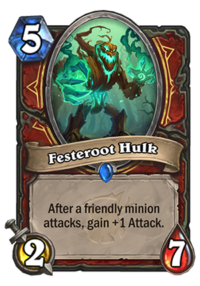
Because of the nature of the
rush mechanic, I was having a difficult time finding a solid tempo play
to make on an empty board on turn 5 in control matchups. Trying various
options such as Bittertide Hydra , Cobalt Scalebane , and even muck
hunter , I found that each had a notable weakness (Bittertide Hydra was
unplayable in half of the matchups due to its weakness to cards like
Arcane Missiles , Cinderstorm , and Avenging Wrath , Cobalt Scalebane never felt
good on an empty board, and the deck didnt have enough reliable
whirlwind effects to run Muck Hunter without it being a liability).
Festeroot Hulk performed surprisingly well, often getting up to 6, 7, or
8 attack before falling and being out of range of a large amount of
removal with its 7 health. The ability to jam it on 5, and proceed to
clear the board with rush minions, or push face damage with chargers to
buff him up before he attacked just felt really good.
Most rush warrior lists that I have seen
run worgens over militia commanders or even both. The 3-3 body of the
worgen was underwhelming to me in that it didn’t have favorable value
trades into many decks other than even paladin, it rarely survived to
combo with Rampage or Rampage , and it never felt good to play on an
empty board. Militia Commander on the other hand, was included to combat
mid game taunts such as Stonehill Defender and Tar Creeper while also
surviving to receive the aforementioned damaged minion synergy effects.
*The removal or worgens from the list did lower the amount of rush
minions from 6 or 7 down to 5 which had the upside of making Town Crier
more consistent in finding a specific rush minion, but also made
Woodcutter's Axe less reliable to find a target for the deathrattle
which is why there is only one axe in the list.
Thanks for
bearing with me through those explanations as I know they were a bit
long winded, however, the refining process of decks is often left out of
the conversation and underappreciated so I wanted to be detailed in
outlining my reasonings behind card choices based on about 200 games of
testing in legend. Anyway, onward to the matchup breakdown!
Matchups

- Even Paladin
Paladin decks are probably the rush warrior’s best matchups giving me
around a 72% winrate over 30 games. Against even paladin your board
control tools line up so well since your 1-drops easily contest the turn
1 silver hand recruit and your 2-drops between Cruel Taskmaster, Redband Wasp, Woodcutter's Axe, and Rampage give you a large variety of tools to deal with their
2-drops. When the call to arms turn comes around, Blood Razor plus a
minion on board usually keeps the board state in your favor. It can
sometimes be difficult to stick the Frothing Berserker in this matchup because of
Truesilver Champion and Blessing of Kings being able to trade into very
efficiently at that mana slot, so ill sometimes hold onto the frothing
on turn 3 unless I have nothing else to play or they had a weak turn 2.
The key to closing this matchup out is to continually keep the board
state in your favor by value trading and to avoid overextending into a
Consecration on 4 or an equality clear past turn 6. If you can find the
time to stick a Festeroot Hulk it will usually finish the game for you
if Grommash Hellscream doesn’t.
- Secret Mage
If you queue into
mage just pray it is secret mage because it is about as good, if not
better than the paladin matchup. The first 4 turns are the most crucial
in this matchup making the mulligan phase especially important. Their
ideal openings are usually Mana Wrym into Sorcerer's Apprentice + spell or
Arcanologist on 2 into Kirin Tor Mage + secret on 3 so the ability to
deal with 3 health minions early is crucial. The main ways this deck
does that is either a 1-drop into Cruel Taskmaster or Woodcutter's Axe , or a
Woodcutter's Axe + Redband Wasp combination. The other way is having
Blood Razor on 4 but that can sometimes be too slow to keep in the
opening hand unless you already have the aforementioned 1 and 2 drops.
If you can manage the board by turn 4 the game is typically in your
favor as long as you keep the board clean and thread in the armor hero
power here and there. The only other caveat to this matchup is playing
around the secrets; because the deck only runs 2 spells, you almost
always want to play around Explosive Runes by sacking a Dire Mole , town
crier or acoloyte of pain into it, unless you already have the board and
are a bit low on life in which Militia Commander and Festeroot Hulk
absorb the damage quite nicely. If you are on the coin, try to save it
if you have Rampage in you first few cards because they will often
damage your minions and landing rampage will often result in them
blowing a turn on Frostbolt or Fireball to clear the threat.
- Control Priest
I don’t have the breadth of experience in this matchup due to just
not finding it on ladder as often as the other top tier decks (only 6%
of games) but the matchup generally feels pretty favorable for us. With
most lists cutting Scaleworm in recent weeks, the deck’s removal package
consists of Duskbreaker , Wild Pyromancer combos, shadow word death , psychic
scream. and Primordial Drake. This makes their early removal options
line up pretty poorly with a rampaged 1-drop, Frothing Berserker , a
Woodcutter's Axe buffed rush minion, and Festeroot Hulk until turn 7.
The game plan generally is to mulligan for a way to clear a turn one Northsire Cleric , stick a 4+ health minion and keep it out of range of Duskbreaker
/ shadow word death while getting them to the point where they have to
play around Grommash Hellscream every turn past turn 8. Keeping a 1 charge
Blood Razor equiped on turn 7+ will usually keep them scared of Grommash Hellscream
to the point where they will either use a weapon removal on it (allowing
you to safely play Scourgelord Garrosh later) or will try to heal out of the 12
point burst range. This is the most common matchup where you can sneak
14-15 damage lethals with a Blood Razor + Grommash Hellscream +Cruel Taskmaster or
Rampage combo on 10 mana.
- Quest Rogue
This matchup ended
up being around a 55-60% winrate for me which was lower than I had
originally expected it to be. It very easy to take the early board, as
would be expected, but pushing the damage can sometimes prove to be
difficult if they manage to have Glacial Shard as their bounce target. Preparation+Vanish can often times prove to be quite a setback as many of the
minions in the deck are not inherently powerful before they have time to
grow (Frothing Berserker and Festeroot Hulk ) or are buffed with Rampage / Woodcutter's Axe .
However, as bad as that all sounds, the matchup is still a favorable one
as they don’t always have both the tools to deal with the boardstate
and develop minions for the quest completion. The majority of the time,
the best way to finish off this matchup is having Blood Razor to get
through Wax Elemental and being able to stick a Frothing Berserker alongside
other minions for a large burst combo.
- Spiteful Druid
This matchup ended being around 55% for me as well and a large reason
for that is not being able to push enough damage, fast enough before the
Spiteful Summoner turn. Despite this though, this is one of the
matchups where the rush package truly shines. The deck packs alot of
defensive tools such as Tar Creeper, crypt lord, and Saronite Chain Gang which
cards like taskmastered Redband Wasp and Militia Commander have a field day
with while still leaving a board of damaged minions to either Rampage or
Battle Rage . The key to winning is usually to stick Frothing Berserker on 3 and
hope they don’t have Druid of the Scythe to clear it off. If they do
manage to stall you long enough, clear your frothing, and develop
Spiteful Summoner the game plan usually switches gears where you play
defensive, clear their spiteful summoned minion and look for Scourgelord Garrosh to
clear the board while trying to set up a Grommash Hellscream lethal. Alot of times,
they get put in a positions where they have to chose between developing
board to pressure you or playing defensive and its riding that line
between threatening with Gromm lethal and developing your own board that
can give you the edge in this matchup. *If you are having an especially
rough time with this matchup, consider swapping either the second Spellbreaker or the second Cruel Taskmaster for a single copy of Execute and
it should help a good bit.
- Warlock
This is by far the
toughest matchup you will face with this deck and even a full tech
against it makes it only bearable rather than favorable (which is the
primary reason I think rush warrior hasn’t seen the light of day in the
competitive spotlight). I will almost always keep both Spellbreaker and
Harrison Jones in this matchup as they are your primary tools for
stabilizing past turn 5 or 6 against Skull of the Man'ari and Possessed Lackey Dark Pact and without
them, the game ends up being just about unwinnable. The primary ways I
have found to win this matchup is getting early damage in with either a
rampaged Dire Mole , a taskmastered Redband Wasp or a Frothing Berserker
into blood razor combo before they have time to spellstone it. The most
important thing is to try to get some early minion damage in. always
save the silence for Voidlord, and try to set up for Grommash Hellscream lethal
very aggressively early. That being said, cubelock is often the easier
of the two matchups compared to control warlock due to them trying to
stick Mountain Giant and sometimes missing the Voidlord and pulling
Doomguard , but be careful about just silencing a Voidlord and leaving it
up, because if they Carnivorous Cube + Dark Pact it, there’s almost no getting past
that.
Closing Thoughts
Anyway, that about wraps up my rush warrior guide! Thanks
to anyone who stuck around to read the whole thing and I hope it was
helpful. Feel free to comment below and either let me know what you
think or ask any questions on topics I didn’t touch on like some notable
exclusions to the list or some of the more obscure matchups.
Lok-tar ogar! Rush on my warriors!


















/rating_1_on.png)
/rating_2_off.png)
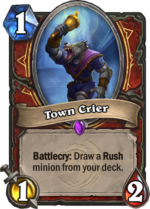
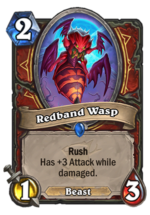
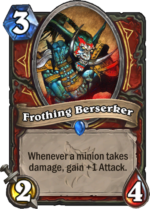
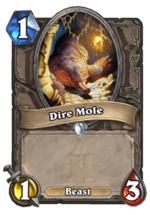


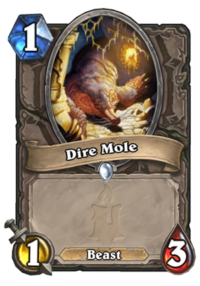
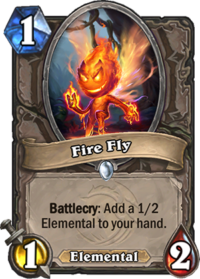
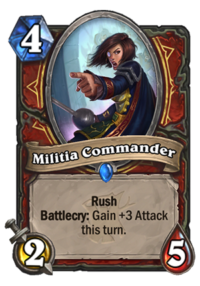
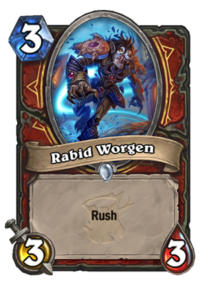
how about deathspeaker as a 3 drop? helps control the board and works well with darius and militia commander
I like it! I agree that the Rabid Worgen needed to go, but now I feel like the deck lacks 3 drops. What about subbing something out for a Tar Creeper?
I agree that an extra tempo 3 drop would be nice. Tar creeper in particular felt too slow because rarely do you need to protect something you developed earlier and it on its own is not a big threat. I’ve seen some lists run vicious fledgling, which is a reasonable threat for the mana cost and probably a solid slot, i just had a hard time making room for it. The other 3 drop that suprised me in testing was Val’kyr Soulclaimer which paired well with animated berserker (over the dire moles). It was super good into paladin and almost always got value because not alot of control decks deal with 4 health easily that early.